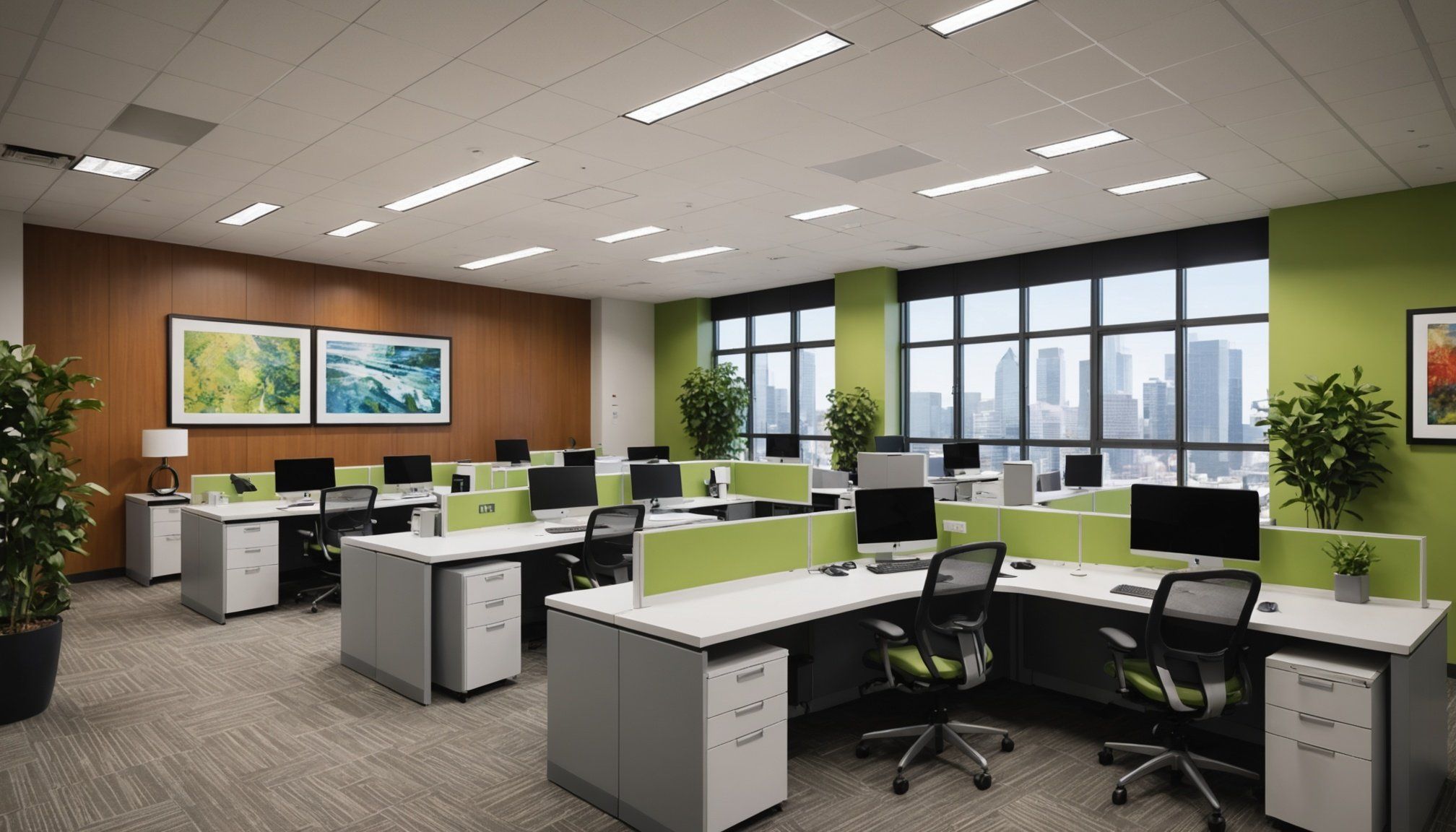Understanding Energy Efficiency in Workspaces
Energy-efficient workspaces are becoming increasingly important in today’s world, where businesses strive to reduce their environmental impact while saving on operational costs. Sustainable office design is integral to this goal, providing numerous benefits for both businesses and the environment.
Modern offices are increasingly focusing on implementing designs that minimise energy consumption through improved office energy management. By adopting measures such as energy-efficient lighting, advanced climate control systems, and optimised building layouts, companies can significantly reduce their energy usage. This not only cuts down on utility bills but also contributes to the global effort to combat climate change.
This might interest you : Revolutionizing Real Estate: Leveraging Geospatial Data for Savvy Market Analysis and Investment Strategies
The benefits of energy-efficient designs extend beyond financial savings. They create healthier work environments, boosting employee productivity and satisfaction—a crucial element in today’s competitive business landscape. Furthermore, showcasing a commitment to sustainability enhances a company’s brand image and attracts eco-conscious clients and employees.
Current trends in workspace energy consumption reveal a growing move towards integrating renewable energy sources and smart technology. Offices are adopting solar panels, wind turbines, and energy-efficient appliances, reflecting a shift toward holistic energy management. These trends underscore the importance of innovative solutions in office energy management, ensuring that workspaces are not only functional and aesthetically pleasing but also play their part in sustaining the planet for future generations.
This might interest you : Revolutionizing Instant Property Valuations with Cutting-Edge AI Technology
Sustainable Design Principles
Sustainable design principles play a crucial role in crafting modern, eco-friendly workspaces. By adhering to green building standards and utilising eco-friendly materials, businesses can significantly reduce their environmental footprint.
Key Elements of Sustainable Office Design
Incorporating energy-efficient windows is vital to enhance climate control, reducing heating and cooling demands. These windows typically feature advanced glazing and insulation technologies, contributing to optimal temperature regulation.
Integrating Natural Light and Ventilation
Maximising natural light and implementing adequate ventilation are key aspects of sustainable office design. By strategically placing windows and open spaces, workplaces can decrease reliance on artificial lighting and mechanical ventilation. This not only reduces energy consumption but also improves employee well-being.
Importance of Insulation and Materials Used
Proper insulation is essential for minimising energy loss in buildings. Using recyclable and sustainable materials—such as bamboo flooring or reclaimed wood—can further reduce the ecological impact of office designs. Selecting materials with a low carbon footprint supports sustainability goals while ensuring durability and aesthetic appeal.
By integrating these sustainable design principles, businesses can transform their offices into energy-efficient workspaces that offer long-term benefits. Reducing energy consumption, lowering costs, and promoting environmentally conscious practices contribute to a healthier planet.
Innovative Techniques for Energy Efficiency
In the pursuit of truly energy-efficient workspaces, integrating innovative techniques is pivotal. Smart technology spearheads this transformation, allowing for real-time energy monitoring. This involves utilizing sensors and IoT devices to track energy usage, identify inefficiencies, and adjust systems automatically, ensuring optimal usage and reducing waste. Businesses can see significant energy savings while maintaining a comfortable environment.
Adopting renewable energy sources like solar panels is another revolutionary approach. Solar technology has become more accessible and cost-effective, allowing offices to generate clean energy on-site. This reduces dependency on traditional energy sources and lowers utility costs, aligning with global sustainability goals.
Energy management systems play a critical role in orchestrating these technologies. By providing a holistic view of energy consumption, these systems facilitate better control and decision-making. They dynamically adjust lighting, heating, and cooling based on occupancy and real-time data, increasing efficiency and reducing costs.
These smart solutions are not just about cutting costs; they represent a commitment to responsible energy use, enhancing corporate sustainability initiatives. Implementing these advanced techniques means businesses can operate more efficiently while minimizing their environmental impact, paving the way for a sustainable future.
Understanding Energy Efficiency in Workspaces
In the realm of energy-efficient workspaces, it is essential to grasp the core concept and significance of this approach in modern offices. Energy efficiency, fundamentally, refers to optimizing resource use while minimizing waste. This is critical as businesses face expanding environmental responsibilities and operational cost challenges. Incorporating these practices can lead to substantial economic and ecological benefits.
The key advantages of energy-efficient designs for businesses and the environment are multifaceted. For companies, adopting such designs results in reduced utility expenses, enhanced employee productivity, and elevated brand image. In the broader context, these efforts contribute to global sustainability objectives, aiding in the fight against climate change by decreasing carbon footprints.
Current trends in workspace energy consumption highlight an emergent shift towards renewable energy sources and intelligent energy management systems. This includes integrating technologies like solar panels and implementing strategies that harness maximum efficiency from available resources, signalling a transformative era in energy utilization. Such trends emphasise the necessity for continuous innovation in office energy management, ensuring that future workspaces not only support business needs but also contribute positively to environmental sustainability. Leveraging these strategies can considerably propel businesses towards a more sustainable operational future.
Case Studies of Successful Energy-Efficient Workspaces
Learning from successful implementations of energy-efficient workspaces offers valuable insights for businesses aiming to enhance their sustainability. These success stories showcase the tangible benefits of investing in sustainability case studies and office redesign examples.
High-Profile Examples of Sustainable Offices
Some high-profile companies have become pioneers in sustainable office design. For instance, Apple’s headquarters in Cupertino, California, leverages natural ventilation and solar energy, achieving remarkable energy efficiency. These successful implementations demonstrate the potential for significant energy savings.
Key Outcomes and Performance Metrics
Performance metrics from these case studies reveal that energy-efficient workspaces can lead to a reduction in energy consumption by up to 40%, as evidenced in redesigned offices like Google’s new campus. This not only curtails operational costs but also reduces the carbon footprint, aligning with global sustainability targets.
Lessons Learned from Implementation
Key lessons from these redesign projects emphasize the importance of strategic planning and cross-departmental collaboration. Engaging employees in the transition process and incorporating their feedback can enhance productivity and satisfaction, as noted in feedback from Microsoft’s sustainable office workers. Success hinges upon a thorough understanding of current energy management systems and their optimised application within the office environment.
Practical Tips for Business Owners and Designers
Creating energy-efficient workspaces requires thoughtful implementation strategies that not only advance sustainability goals but also boost business operations. To begin, business owners should evaluate current energy efficiency levels in their offices by conducting an energy audit. This helps identify areas of high energy consumption and potential improvements.
For companies embarking on a redesign project, focusing on workplace sustainability tips is key. Start by integrating features like energy-effective lighting and climate control systems tailored to specific needs, ensuring optimal efficiency. The careful selection of materials is crucial, opting for those that reflect sustainable design principles. These small shifts can result in considerable energy savings.
Collaboration with sustainability experts and consultants can provide insightful guidance. Experts bring practical experience, offering tailored advice that can streamline the transition to a more energy-efficient office. Their knowledge is invaluable in aligning projects with current green building standards.
Including employees in the process fosters a culture of sustainability. Encourage their engagement and feedback on workspace design, which can enhance satisfaction and productivity. By implementing these practical tips, businesses can successfully transform their workspaces into greener, sustainable environments that support long-term ecological and economic benefits.



